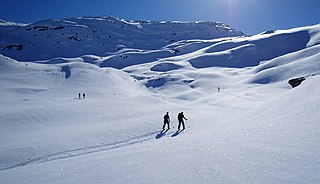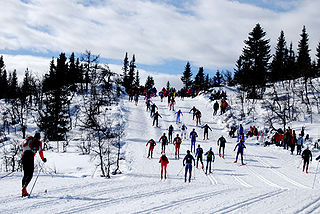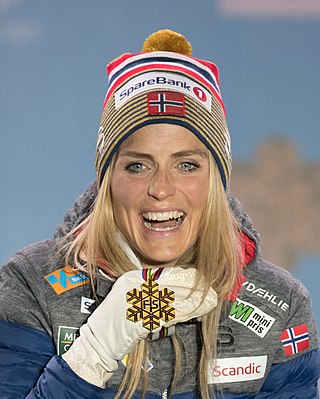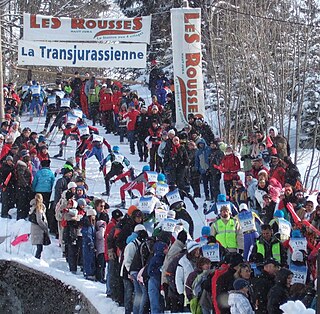Locations
Only one and the best race from a country can be a member of Worldloppet. There are (written 2015) 20 races, spread amongst Europe, America, Asia and Australia:
| Formation | 10 June 1978 |
|---|---|
| Founded at | Uppsala, Sweden |
| Type | sports governing body |
| Headquarters | Tartu |
| Location | |
Official language | English, Swedish |
| Website | https://www.worldloppet.com/ |
The Worldloppet Ski Federation is an international federation of long distance cross-country skiing events whose aim is to promote cross-country skiing through ski races. The federation was founded on 10 June 1978 in Uppsala, Sweden. [1]
Only one and the best race from a country can be a member of Worldloppet. There are (written 2015) 20 races, spread amongst Europe, America, Asia and Australia:
Actual racing distances may vary from year to year according to the local snow conditions, but usually, there are different categories: full distance (at least 42 km, the length of a non-skiing marathon (26 miles)) and shorter ones for children and less experienced skiers. For Vasaloppet, the oldest of the races, the full distance is about 90 km (56 mi). Some races are freestyle (both skating and classic are allowed), but others only permit classic style.
Those who complete Worldloppet races in 10 different countries, at least one of which is from a continent other than Europe, qualify as a Worldloppet Master. They qualify for Worldloppet Gold Master if they have completed 10 main races, or a Silver Master if they have competed 10 races where some or all of them are short races. As of October 2019, more than 5,000 master titles have been issued.

Cross-country skiing is a form of skiing whereby skiers traverse snow-covered terrain without use of ski lifts or other assistance. Cross-country skiing is widely practiced as a sport and recreational activity; however, some still use it as a means of travel. Variants of cross-country skiing are adapted to a range of terrain which spans unimproved, sometimes mountainous terrain to groomed courses that are specifically designed for the sport.

Skiing is the use of skis to glide on snow. Variations of purpose include basic transport, a recreational activity, or a competitive winter sport. Many types of competitive skiing events are recognized by the International Olympic Committee (IOC), and the International Ski and Snowboard Federation (FIS).

The FIS Alpine Ski World Cup is the top international circuit of alpine skiing competitions, launched in 1966 by a group of ski racing friends and experts which included French journalist Serge Lang and the alpine ski team directors from France and the USA. It was soon backed by International Ski Federation president Marc Hodler during the FIS Alpine World Ski Championships 1966 at Portillo, Chile, and became an official FIS event in the spring of 1967 after the FIS Congress at Beirut, Lebanon.

Vasaloppet is an annual long distance cross-country ski race held on the first Sunday of March. The 90 km (56 mi) course starts in the village of Berga, just south of Sälen in western Dalarna, Sweden, and ends in the town of Mora in the central part of the province. It is the oldest cross-country ski race in the world, as well as the one with the highest number of participants.

The American Birkebeiner, or Birkie, is the largest cross-country skiing race in North America. It debuted in 1973 and is a founding member of the Worldloppet federation of cross-country ski marathons. The Birkie's two premier events are the 50 km (31 mi) skate and the 55 km (34 mi) classic races between the towns of Cable and Hayward in the U.S. state of Wisconsin. Each year more than 10,000 skiers participate in the Birkie, including the full-distances races, a 29 km (18 mi) Kortelopet race, and a 15 km (9.3 mi) Prince Haakon race.

Skijoring is a winter sport in which a person on skis is pulled by a horse, a dog, another animal, or a motor vehicle. The name is derived from the Norwegian word skikjøring, meaning "ski driving". Although skijoring is said to have originated as a mode of winter travel, it is currently primarily a competitive sport.

Roller skiing is an off-snow equivalent to cross-country skiing. Roller skis have wheels on their ends and are used on a hard surface, to emulate cross-country skiing. The skiing techniques used are very similar to techniques used in cross-country skiing on snow.

Birkebeinerrennet is a long-distance cross-country ski marathon held annually in Norway. It debuted in 1932 and has been a part of Worldloppet since Worldloppet's inception in 1979.

Paralympic cross-country skiing is an adaptation of cross-country skiing for athletes with disabilities. Paralympic cross-country skiing is one of two Nordic skiing disciplines in the Winter Paralympic Games; the other is biathlon. Competition is governed by the International Paralympic Committee (IPC).
Cristina Paluselli is a former professional Italian cross-country skier.

The Tour de Ski (TdS) is a cross-country skiing event held annually since the 2006–07 season in Central Europe, modeled on the Tour de France of cycling. The Tour de Ski is a Stage World Cup event in the FIS Cross-Country World Cup. Each Tour de Ski has consisted of six to nine stages, held during late December and early January in the Czech Republic, Germany, Italy, and Switzerland. As of 2023, the prize money for the event amount to 770,000 Swiss francs (779,000 euros), shared out on both men and women. Men's and women's events are held together on the same days, with the only difference being the distance skied.

Petra Majdič is a Slovenian former cross-country skier. Her best results came in classic style races. She won twenty-four World Cup races, twenty in sprint races, but she also won a marathon in Trondheim in 2009. She is the first Slovenian cross-country skier to win a World Cup race, the first to get a medal at the World Championships and the first to get an Olympic medal. With 20 wins, Majdič is the second-most successful sprinter in FIS Cross-Country World Cup history and with 24 wins in total she's the fourth-most successful World Cup competitor of all time.

Therese Johaug is a former Norwegian cross-country skier from the village of Dalsbygda in Os municipality who has competed for the clubs Tynset IF and IL Nansen. In World Ski Championships she has won ten individual gold medals along with four gold medals in relays, and she is a four-time Olympic gold medallist.

Marcialonga is a cross-country ski race which is arranged for the last Sunday in January in Trentino in Italy. It was first held in 1971 and has been a part of Worldloppet as long as Worldloppet has been around.

Dario Cologna is a Swiss retired cross-country skier. He has four overall World Cup victories, four Olympic gold medals, one World Championships gold medal and four Tour de Ski victories in his career.

The FIS Cross-Country World Cup is an annual cross-country skiing competition, arranged by the International Ski Federation (FIS) since 1981. The competition was arranged unofficially between 1973 and 1981, although it received provisional recognition on the 31st FIS Congress, 29–30 April 1977 in Bariloche, Argentina.
The Engadin Skimarathon is an annual cross-country skiing race held on the second Sunday of March in the upper Engadine valley (Switzerland), between Maloja and S-chanf. It debuted in 1969 and has been a part of Worldloppet as long as Worldloppet has existed. It is one of the major cross-country skiing events in the Alps. Between 11,000 and 14,200 skiers participate each year. The total distance covered is 42 km, although it is also possible to complete the half-marathon of 21 km or the 17 km Women's Race. While it is a freestyle race, there are separate tracks for skiers practicing classic style for all but the narrowest parts of the race. Participation is open to anyone from the age of 16, and no licence is required to sign up.

The Transjurassienne is an annual cross-country ski race held on the second Weekend of February between Lamoura and Mouthe in the French Jura mountains. It debuted in 1980 and has been a part of Worldloppet since 1981. It is also part of the FIS Marathon Cup and the biggest cross-country skiing event in France. More than 4,000 skiers participate over the two days each year. Saturday is devoted to classic-style with races taking place over 25 km and 50 km. The main race takes place on Sunday - the 76 km long Tranjurassienne in skating-style - the longest skating race on the Worldloppet tour. Shorter races over 57 km and 25 km are also offered. Participation is open to anyone from the age of 16, and while no licence is required to sign up, the organisers demand a medical certificate to demonstrate the ability to take part in a long-distance skiing event.

Competitive cross-country skiing encompasses a variety of race formats and course lengths. Rules of cross-country skiing are sanctioned by the International Ski Federation and by various national organizations. International competitions include the FIS Nordic World Ski Championships, the FIS Cross-Country World Cup, and at the Winter Olympic Games. Such races occur over homologated, groomed courses designed to support classic (in-track) and freestyle events, where the skiers may employ skate skiing. It also encompasses cross-country ski marathon events, sanctioned by the Worldloppet Ski Federation, and cross-country ski orienteering events, sanctioned by the International Orienteering Federation. Related forms of competition are biathlon, where competitors race on cross-country skis and stop to shoot at targets with rifles, and paralympic cross-country skiing that allows athletes with disabilities to compete at cross-country skiing with adaptive equipment.